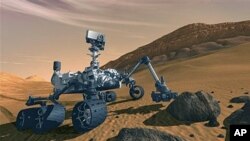NASA's newest Mars rover is set to leave Earth at the end of this year and reach the Red Planet in August 2012. It's called the Mars Science Laboratory - MSL for short or 'Curiosity' to the masses. And Curiosity has a now-official destination - a promising piece of Martian landscape called Gale Crater.
The Curiosity rover is the size of a car, has 17 cameras, a robotic arm, a laser and a drill. About one year from now, NASA expects to see it making tracks on Mars.
John Grotzinger is the mission's project scientist at the California Institute of Technology. He told reporters in Washington on Friday that the research team has such detailed information about the Martian landscape and enough engineering know-how that they can choose an exact landing spot. They have decided it is going to be at the foot of a mountain that's located within a deep, 150-kilometer-wide depression called Gale Crater.
"The thing about this mountain is that it's not a tall spire. It's a broad, low mound-like shape," said Grotzinger. "What that means is that we can drive up it with a rover, so this might be the tallest mountain anywhere in the solar system that we could actually climb with a rover."
Crater is prime spot
Grotzinger said another reason they chose Gale as a landing spot is because it is in a low-elevation position - and water runs downhill. Researchers are going to use the rover to study whether the Gale Crater ever had environmental conditions that could have supported microbial life.
The mission is set to last two years, but Grotzinger says if the $2.5-billion Curiosity continues to function, it might be able to keep climbing up that mountain.
If history is any indication, Curiosity could keep exploring well beyond the two-year mark. NASA's Mars Exploration Rovers, Spirit and Opportunity - essentially Curiosity's smaller cousins - outlasted their missions by years.
Fully equipped vehicle
Curiosity can rove along Martian terrain on its six wheels at a maximum speed of about four centimeters per second. It is the largest of the rovers NASA has sent to Mars, weighing in at 900 kilograms and measuring about two meters tall and about three meters long and high. That makes it five times heavier and about twice as long as the exploration rovers Spirit and Opportunity.
NASA explains that the larger size allows for the rover to carry more scientific instruments.
Grotzinger said there are 10 instruments on Curiosity.
"We can start off with everybody's favorite, which are the cameras. On MSL we have 17 cameras," he said. "You all are going to get lots of pictures to look at."
Roaming shutterbug
He said a camera that is mounted to the bottom of the rover will take pictures as the craft is landing on Mars, snapping five frames per second in full color, essentially making a movie of the landing.
"We have cameras that are up on top of the mast that we can use to look around and try to find the types of rocks that we would like to do chemical analysis on," said Grotzinger. "And when we think that something is particularly promising, we can drive up closer and then we have a laser that shoots out in front of the rover, up to a distance of seven meters away that zaps the rock, creates a spark of light, and then we look at that spark and based on the light content, it tells us about what chemical elements are in the rock and are they the kind of chemical elements that are consistent with a habitable environment."
Grotzinger said if the research team wants to investigate further, Curiosity can drill the rock to create a powder and use its robotic arm to collect that powder and drop it into holes in the rover where there are instruments for further analysis. That underscores the "laboratory" element in Curiosity's formal name "Mars Science Laboratory."
Curiosity and the spacecraft components that will deliver the rover to the Martian surface are being assembled and undergoing final testing. NASA plans a launch from the Kennedy Space Center in Florida between late November and mid-December of this year.














